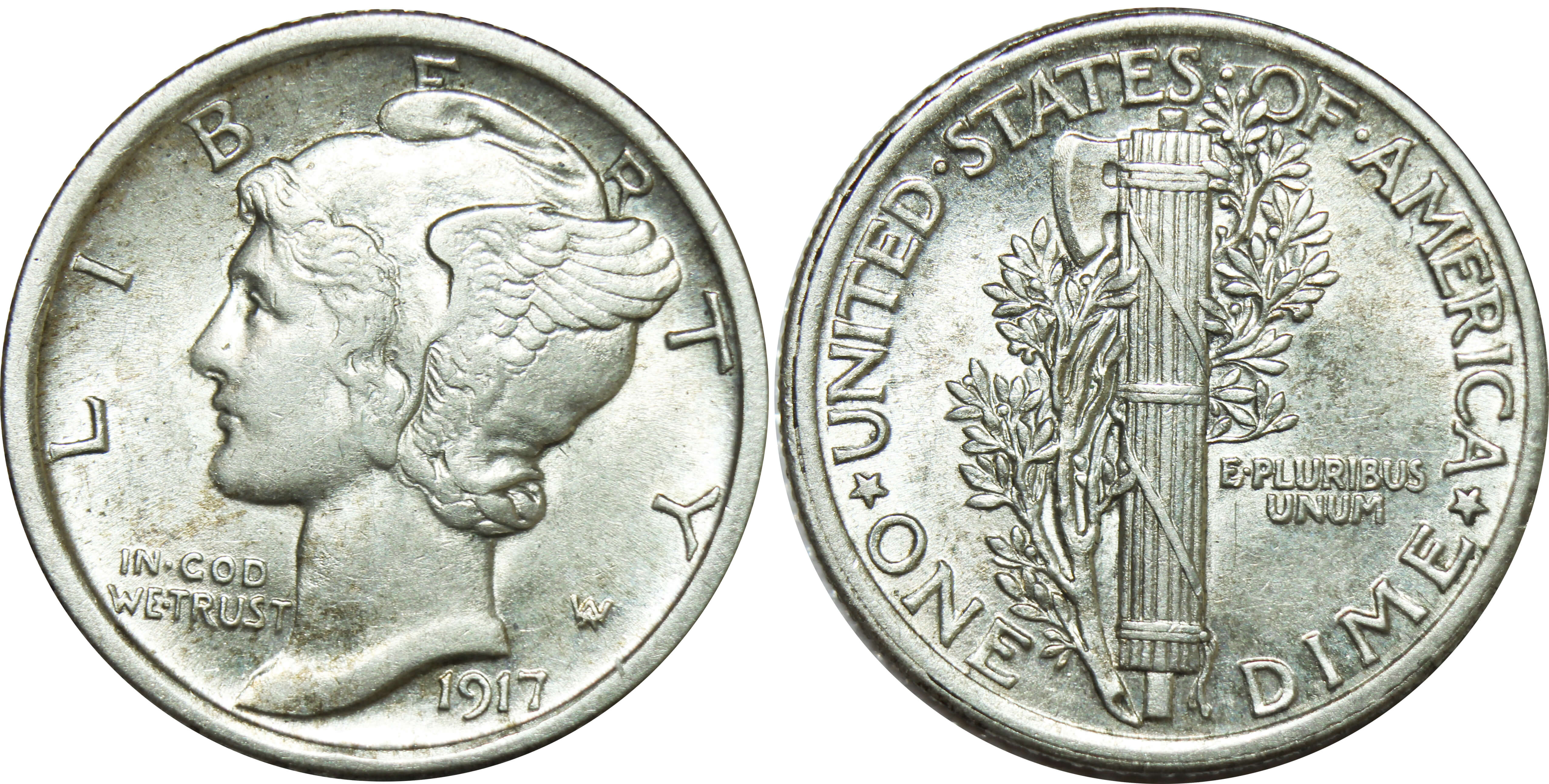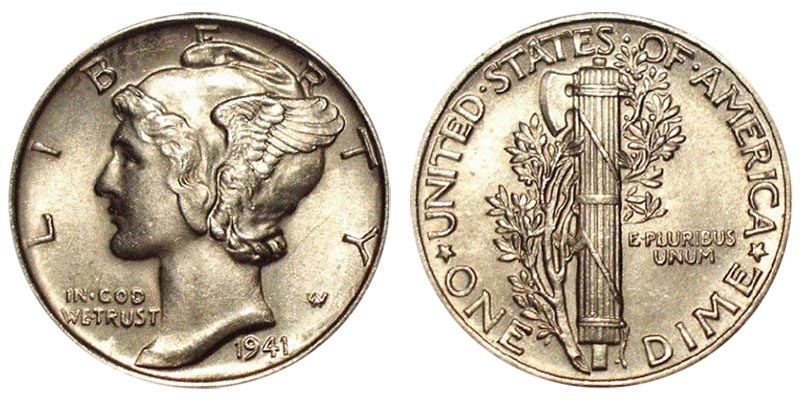Mercury Dime (1916–1945): Values & History
Values of Mercury dimes have a wide range. They may be just a few dollars on the low end to mid-six-figures on the high end.
The highest values are for uncirculated examples with Full Band (FB) details in the faces on the reverse. On the low end, you will find well-worn common dates that sell for their base silver value.
Mercury Dimes: Values Dependent on Various Factors
As introduced above, Mercury dimes range in the value scale. There is something available for practically every budget.

1917 Mercury dime
The Mercury dime series does not boast many key dates, semi-keys, or rare varieties, but those that it does offer are quite valuable. These include the series key 1916-D, the semi-key 1921 and 1921-D, and the 1942/1 and 1942/1-D overdates.
There are also some other notable pieces, including the 1926-S, 1931-D, and 1945-S Micro S. These three are considered "better dates." They are relatively affordable in circulated grades but quite expensive in the Mint State grades.
Then there are the FB Mercury dimes. These coins show a stronger strike and overall better eye appeal than those that do not have this detail in the horizontal lines of the bands. On some Mercury dimes, the FB detail is the rule rather than the exception. However, on many issues, FB details are extraordinarily scarce.
One of the most valuable Mercury dimes ever sold at public auction commanded its price in large part due to the presence of FB details. This specimen, a 1938-S Mercury dime graded Mint State-68 FB by Professional Coin Grading Service, took an astounding $364,250.
At the other end of the spectrum are the well-worn common dates. These dates include 1941, 1942, 1943, 1944, and 1945 Mercury dimes that may trade for as little as melt value. These coins are often included in pre-1965 “junk silver” bags and are quite affordable. Mercury dimes enjoy an excellent crossover appeal between both coin collectors and precious metals investors.
What Are Mercury Dimes Worth?
The values of Mercury dimes can be broken down into a few categories. These include:
The circulated common dates – Worth close to melt value.
Semi-keys and varieties – These trade at significant premiums and are listed below.
The key – Namely the 1916-D, which takes many hundreds of dollars even in damaged condition and is also listed below.
FBs and others – These high-end specimens generally sell for multiples of their non-FB counterparts.
Proofs – Struck only from 1936-1942, the latter years of the series; these will be further examined below.
For the sake of space, we are going to focus on the values of the scarcer, more notable Mercury dimes. Generally speaking, all of the regular issues made after 1931 are worth close to melt value, unless in the grades of Extremely Fine or better.
These most notable pieces include:
*Values are for problem-free examples in Fine-12 condition
What can one glean from this price list above? Several things. Namely, of the 77-coin basic set, there are only a relative handful of coins that are worth remarkable prices in the circulated grades.
Also, because of the small number of expensive coins, most of a Mercury dime set can be built for an affordable price. Again, most of the dates NOT mentioned above can be bought in the lower grades for at or near melt.
Another exciting thing that may stand out here is that even the most expensive issues aren’t prohibitively expensive. The prices above are for specimens grading Fine-12. A collector willing to stick to the Good-4 range can buy these same coins for much lower prices.
Collecting Mercury Dimes
The Mercury dime is considered by many as one of the most beautiful small denominations the United States Mint has ever struck. The Mercury Dime was designed by Adolph A. Weinman and was in production from 1916 through 1945.
Also known as the “Winged Liberty Head” dime, this 10-cent piece has become one of the favorite collectibles of the 20th century. This coin was eventually dubbed the “Mercury” dime, which was due to Miss Liberty’s resembling the Roman god Mercury.
The Mercury Dime was one of the first contemporary coins that collectors actively sought in circulation by date and mintmark. This phenomenon was greatly aided by the advent of inexpensive coin boards and coin folders by the late 1930s and early 1940s.

1941 Mercury dime. Image: USA CoinBook
Mercury dimes offer hobbyists a variety of collecting opportunities. You may pursue the relatively simple goal of building a World War II date set of issues ranging from 1941 through 1945. Or you could tackle the decidedly more complicated and expensive objective of building a complete date-and-mintmark set including major varieties.
Many collectors customize their set-building ambitions according to their disposable income availability. And, thankfully, the Mercury dime series offers excellent flexibility in this respect.
Full-Bands & Proof Mercury Dimes
In general, prices in the series aren’t necessarily expensive. This is not to say, however, that there isn’t the chance of financial challenge for those with deeper pockets and more advanced tastes. Remember that six-figure Mercury dime mentioned earlier? It’s a 1938-S—a common date in the absolute sense but rare in the highest Mint State grades with FB grade designation.
Some Mercury dimes are almost impossible to find in the FB range, including the 1945 Philadelphia. This date is oddly very common in the absolute sense but esoteric with FB details. The 1945 Philly issue with Full Bands goes for about $20,000 in a grade of Mint State-66!
Values for Full Bands Mercury Dimes are all over the board. They often vary not just by the grade point given for a said piece but also by its overall eye appeal. The area of pricing for FB Mercury dimes is exceptionally nuanced. Mercury Dime collectors may be best served to research the series. It would be best if you considered the individual merits and pricing considerations for each issue.

Close up view of Full Bands on a Mercury dime. Image: PCGS
Proof Mercury dimes represent a small sliver of the series, as these were produced for only a few years toward the end of the production run. Since the mid-19th century, the United States Mint had been striking proof coins. The Mint generally stopped making these special collector issues in 1916, the year the Mercury dime was launched. This hiatus continued until 1936.
Mercury dimes were produced in proof from then until 1942 when proof strikes again came to a halt during the height of World War II. The war ended the year the last Mercury dimes were minted. However, proofs did not resume at the United States Mint until 1950, by which time the Roosevelt dime supplanted the Mercury type.
Pricing for proof Mercury dimes is rather straightforward. Typical examples in the Proof-65 range sell for between $200 and $500 apiece. The only exception to this is the 1936 proof Mercury dime, which lists for closer to $850 and up.
Also worth noting is that the values for proof Mercury dimes are mostly dependent on individual eye appeal. Nicer specimens trade for much more than typical prices; cloudy or spotted examples sell for less.
Joshua McMorrow-Hernandez is a journalist, editor, and blogger who has won multiple awards from the Numismatic Literary Guild. He has also authored numerous books, including works profiling the history of the United States Mint and United States coinage.
More information about collecting dimes from the author:
How Much Is a Silver Dime Worth?
Most Valuable Dimes: Comprehensive List for Collectors
Key Date Barber Dimes: Price Guide
Key Date Mercury Dimes: 1916-D, 1921, 1921-D
